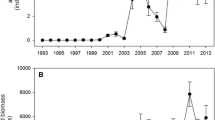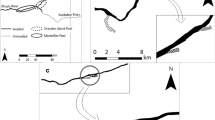Abstract
Bighead carp (Hypophthalmichthys nobilis) and silver carp (H. molitrix), collectively known as Asian carp, are planktivorous fishes that have invaded aquatic ecosystems throughout the Mississippi River Basin of North America. Consequently, Asian carp management plans (including contractual harvest) have been implemented to prevent range expansion into vulnerable systems such as the Great Lakes. Asian carp harvest also provides an opportunity to assess if control efforts can benefit native fishes. To answer this question, 26 years of standardized electrofishing data were analyzed, focusing on gizzard shad (Dorosoma cepedianum) body condition (W r) and abundance (catch-per-unit-effort, CPUE) from the Illinois River (Illinois, USA). Gizzard shad data were categorized into pre-Asian carp establishment (1990–1999), after Asian carp establishment (2000–2009), and harvest (2010–2014) periods. Gizzard shad W r and small gizzard shad CPUE decreased in the entire river after Asian carp invasion, and W r and large gizzard shad CPUE rebounded where harvest occurred. Contrastingly, small gizzard CPUE has not yet exhibited a positive response to harvest. These mixed results indicate a time-lag may exist between management action and ecosystem response. Ultimately, Asian carp removal may be facilitating improvements in gizzard shad body condition (by increasing forage availability), which may portend a future gizzard shad population rebound.




Similar content being viewed by others
References
Asian Carp Monitoring and Response Working Group (ACMRWG), 2016. 2015 Asian Carp Monitoring and Response Plan. Illinois, Chicago.
Asian Carp Regional Coordinating Committee (ACRCC), 2016. Asian Carp Action Plan for Fiscal Year 2017. Council on Environmental Quality, Washington, DC.
Anderson, R. O. & S. J. Gutreuter, 1983. Length, weight, and associated structural indices. In Nielsen, L. A. & D. L. Johnson (eds), Fisheries Techniques. American Fisheries Society, Bethesda: 283–300.
Anderson, R. O. & R. M. Neumann, 1996. Length, weight, and associated structural indices. In Murphy, B. R. & D. W. Willis (eds), Fisheries Techniques, 2nd ed. American Fisheries Society, Bethesda: 447–482.
Balon, E. K., 1979. The theory of saltation and its application in the ontogeny of fishes: steps and thresholds. Environmental Biology of Fishes 4: 97–101.
Bodola, A., 1955. The life history of the gizzard shad Dorosoma cepedianum (Lesueur) in western Lake Erie. Doctoral Dissertation, The Ohio State University, Columbus: 1–130.
Cargnelli, L. M. & M. R. Gross, 1997. Notes: fish energetics: larger individuals emerge from winter in better condition. Transactions of the American Fisheries Society 126: 153–156.
Christie, G. C. & C. I. Goddard, 2003. Sea Lamprey International Symposium (SLIS II): advances in the integrated management of sea lamprey in the Great Lakes. Journal of Great Lakes Research 29: 1–14.
Cooke, S. L. & W. R. Hill, 2010. Can filter-feeding Asian carp invade the Laurentian great lakes? A bioenergetic modelling exercise. Freshwater Biology 55: 2138–2152.
Coulter, D. P., R. MacNamara, D. C. Glover & J. E. Garvey, In review. Density, biomass, and competitive effects of bigheaded carp across an invasion gradient. Biological Conservation.
Cushing, D. H., 1990. Plankton production and year-class strength in fish populations: an update of the match/mismatch hypothesis. Advances in Marine Biology 26: 249–293.
DeBoer, J. A., A. M. Anderson & A. F. Casper, In review. Multi-trophic response to invasive Asian Carp in a large floodplain river. Freshwater Biology.
DeGrandchamp, K. L., J. E. Garvey & R. E. Colombo, 2008. Movement and habitat selection by invasive asian carps in a large river. Transactions of the American Fisheries Society 137: 45–56.
Fritts, M. W., J. A. DeBoer, D. K. Gibson-Reinemer, B. J. Lubinski, M. A. McClelland & A. F. Casper, 2017. Over a half-century of fish community monitoring in Illinois’ large rivers: the evolution of methods used by the Illinois Natural History Survey and Assessment of Large River Fishes in Illinois Monitoring Program. Illinois Natural History Survey Bulletin 41(1): 1–18.
Gibson-Reinemer, D. K., L. E. Solomon, R. M. Pendleton, J. H. Chick & A. F. Casper, 2017. Hydrology controls recruitment of two invasive cyprinids: bigheaded carp reproduction in a navigable large river. PeerJ 5: e3641.
Henderson, S., 1976. Observations on the Bighead and Silver Carp and Their Possible Application in Pond Fish Culture. Arkansas Game and Fish Commission, Little Rock.
Hoff, M. H., M. A. Pegg & K. S. Irons, 2011. Management implications from a stock-recruit model for bighead carp in portions of the Illinois and Mississippi River. In Chapman, D. C. & M. H. Hoff (eds), Invasive Asian Carps in North America. American Fisheries Society, Bethesda: 5–14.
Irons, K. S., G. G. Sass, M. A. McClelland & J. D. Stafford, 2007. Reduced condition factor of two native fish species coincident with invasion of non-native Asian carps in the Illinois River, U.S.A. Is this evidence for competition and reduced fitness? Journal of Fish Biology 71: 258–273.
Kolar, C. S., D. C. Chapman, W. R. Courtenay, C. M. Housel, J. D. Williams & D. P. Jennings, 2007. Bigheaded Carps: A Biological Synopsis and Environmental Risk Assessment. American Fisheries Society, Bethesda.
Leggett, W. C. & E. Deblois, 1994. Recruitment in marine fishes: is it regulated by starvation and predation in the egg and larval stages? Netherlands Journal of Sea Research 32: 119–134.
MacNamara, R., D. Glover, J. Garvey, W. Bouska & K. Irons, 2016. Bigheaded carps (Hypophthalmichthys spp.) at the edge of their invaded range: using hydroacoustics to assess population parameters and the efficacy of harvest as a control strategy in a large North American River. Biological Invasions 18: 3293–3307.
Maher, R., 2015. 2015 Commercial Catch Report Exclusive of Lake Michigan. Illinois Department of Natural Resources, Alton.
Michaletz, P. H., 1997. Influence of abundance and size of age-0 gizzard shad on predator diets, diet overlap, and growth. Transactions of the American Fisheries Society 126: 101–111.
Minder, M. & M. Pyron, 2017. Dietary overlap and selectivity among silver carp and two native filter feeders in the Wabash River. Ecology of Freshwater Fish. https://doi.org/10.1111/eff.12365.
Mundahl, N. D. & T. E. Wissing, 1987. Nutritional importance of detritivory in the growth and condition of gizzard shad in an Ohio reservoir. Environmental Biology of Fishes 20: 129–142.
Pendleton, R. M., C. Schwinghamer, L. E. Solomon & A. F. Casper, In press. Competition among river planktivores: are native planktivores still fewer and skinnier in response to the Asian Carp invasion? Environmental Biology of Fishes.
Sampson, S. J., J. H. Chick & M. A. Pegg, 2009. Diet overlap among two Asian carp and three native fishes in backwater lakes on the Illinois and Mississippi Rivers. Biological Invasions 11: 483–496.
Sass, G. G., C. Hinz, A. C. Erickson, N. N. McClelland, M. A. McClelland & J. M. Epifanio, 2014. Invasive bighead and silver carp effects on zooplankton communities in the Illinois River, Illinois, USA. Journal of Great Lakes Research 40: 911–921.
Schaus, M. H., M. J. Vanni & T. E. Wissing, 2002. Biomass-dependent diet shifts in omnivorous gizzard shad: implications for growth, food web, and ecosystem effects. Transactions of the American Fisheries Society 131: 40–54.
Schrank, S. J., C. S. Guy & J. F. Fairchild, 2003. Competitive interactions between age-0 bighead carp and paddlefish. Transactions of the American Fisheries Society 132: 1222–1228.
Schiemer, F., H. Keckeis & E. Kamler, 2002. The early life history stages of riverine fish: ecophysiological and environmental bottlenecks. Comparative Biochemistry and Physiology Part A: Molecular & Integrative Physiology 133: 439–449.
Smith, E. P., 2002. BACI design. In El-Shaarawi, A. H. & W. W. Piegorsch (eds), Encyclopedia of Environmetrics. Wiley, Chichester: 141–148.
Sparks, R. E., J. C. Nelson & Y. Yin, 1998. Naturalization of the flood regime in regulated rivers. BioScience 48: 706–720.
Starrett, W. C., 1972. Man and the Illinois river. In Oglesby, R. T., C. A. Carlson & J. A. McCann (eds), River Ecology and Man. Academic Press, New York: 131–169.
Strayer, D. L., K. A. Hattalal, A. W. Kahnle & R. D. Adams, 2014. Has the Hudson River fish community recovered from the zebra mussel invasion along with its forage base? Canadian Journal of Fisheries and Aquatic Sciences 71: 1146–1157.
Thompson, P. D. & F. J. Rahel, 1996. Evaluation of depletion-removal electrofishing of brook trout in small rocky mountain streams. North American Journal of Fisheries Management 16: 332–339.
Vörös, L., I. Oldal, M. Présing & K. V. Balogh, 1997. Size-selective filtration and taxon-specific digestion of plankton algae by silver carp (Hypophthalmichthys molitrix Val.). In Kufel, L., A. Prejs & J. I. Rybak (eds), Shallow Lakes’ 95. Springer, Dordrecht: 223–228.
Williamson, C. J. & J. E. Garvey, 2005. Growth, fecundity, and diets of newly established silver carp in the middle Mississippi River. Transactions of the American Fisheries Society 6: 1423–1430.
Willis, D. W., 1987. Reproduction and recruitment of gizzard shad in Kansas reservoirs. North American Journal of Fisheries Management 7: 71–80.
Yallaly, K. L., J. R. Seibert & Q. E. Phelps, 2015. Synergy between silver carp egestion and benthic fishes. Environmental Biology of Fish 98: 511.
Zeug, S. C. & K. O. Winemiller, 2007. Ecological correlates of fish reproductive activity in floodplain rivers: a life-history-based approach. Canadian Journal of Fisheries and Aquatic Sciences 64: 1291–1301.
Acknowledgements
We thank former and current Illinois River Biological Station staff for their dedication in collecting data used in these analyses. We also thank several agencies for providing funding for this project: the U.S. Environmental Protection Agency’s Great Lakes Restoration Initiative funding administered by the Illinois Department of Natural Resources (Project #CAFWS-106), and the U.S. Fish and Wildlife Service Federal Aid in Sport Fish Restoration administered through the Illinois Department of Natural Resources (IDNR Grant #F-101-R). Additionally, we thank those who constructively reviewed and improved this manuscript.
Author information
Authors and Affiliations
Corresponding author
Additional information
Guest editors: John E. Havel, Sidinei M. Thomaz, Lee B. Kats, Katya E. Kovalenko & Luciano N. Santos / Aquatic Invasive Species II
Rights and permissions
About this article
Cite this article
Love, S.A., Lederman, N.J., Anderson, R.L. et al. Does aquatic invasive species removal benefit native fish? The response of gizzard shad (Dorosoma cepedianum) to commercial harvest of bighead carp (Hypophthalmichthys nobilis) and silver carp (H. molitrix). Hydrobiologia 817, 403–412 (2018). https://doi.org/10.1007/s10750-017-3439-1
Received:
Revised:
Accepted:
Published:
Issue Date:
DOI: https://doi.org/10.1007/s10750-017-3439-1




